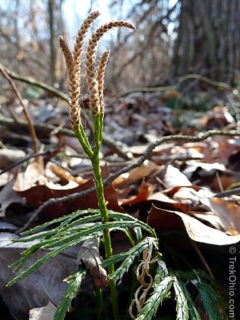 The above plant has a number of names. I'm going to go with Ground Cedar, but it belongs to a family of plants (a genus) that's also called Groundcedar, Crowsfoot, and Clubmoss. I'm not absolutely certain, but I think its specific species is Diphasiastrum digitatum. It is a vascular plant which means that it has veins within its stem and leaves for transporting fluids, minerals and food. Before I became acquainted with it, I had thought that ferns were the only vascular plants that reproduced Read more ➜
The above plant has a number of names. I'm going to go with Ground Cedar, but it belongs to a family of plants (a genus) that's also called Groundcedar, Crowsfoot, and Clubmoss. I'm not absolutely certain, but I think its specific species is Diphasiastrum digitatum. It is a vascular plant which means that it has veins within its stem and leaves for transporting fluids, minerals and food. Before I became acquainted with it, I had thought that ferns were the only vascular plants that reproduced Read more ➜ Ground Cedar and Its Combustible Spores
 The above plant has a number of names. I'm going to go with Ground Cedar, but it belongs to a family of plants (a genus) that's also called Groundcedar, Crowsfoot, and Clubmoss. I'm not absolutely certain, but I think its specific species is Diphasiastrum digitatum. It is a vascular plant which means that it has veins within its stem and leaves for transporting fluids, minerals and food. Before I became acquainted with it, I had thought that ferns were the only vascular plants that reproduced Read more ➜
The above plant has a number of names. I'm going to go with Ground Cedar, but it belongs to a family of plants (a genus) that's also called Groundcedar, Crowsfoot, and Clubmoss. I'm not absolutely certain, but I think its specific species is Diphasiastrum digitatum. It is a vascular plant which means that it has veins within its stem and leaves for transporting fluids, minerals and food. Before I became acquainted with it, I had thought that ferns were the only vascular plants that reproduced Read more ➜ 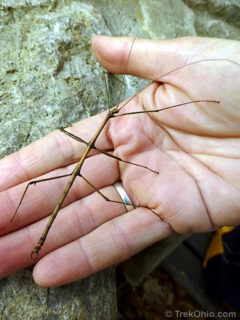 I was in luck as I approached the Nature Center at Blendon Woods Metro Park in Columbus. A staff member told me that she was just about to release a walking stick into the wild, and she asked me if I'd like to watch. You'll note that the insect above has a pincer like appendage at the end of its abdomen. She explained to me that this meant this particular insect was a male walking stick. The appendage is used to grip the female while mating. Another difference between the sexes is that the male is
I was in luck as I approached the Nature Center at Blendon Woods Metro Park in Columbus. A staff member told me that she was just about to release a walking stick into the wild, and she asked me if I'd like to watch. You'll note that the insect above has a pincer like appendage at the end of its abdomen. She explained to me that this meant this particular insect was a male walking stick. The appendage is used to grip the female while mating. Another difference between the sexes is that the male is 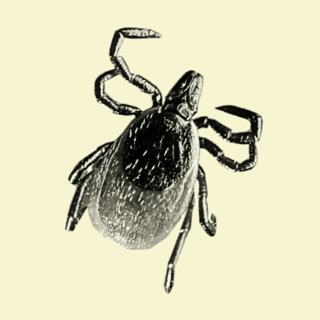 Although Ohio has a number of tick species, the species which carries Lyme disease has been relatively absent from our state… until now. The Lyme-carrying tick is the Black Legged Tick, also known as the Deer Tick (Ixodes scapularis). There are now established populations of Black Legged Ticks in 26 Ohio counties including Franklin and Delaware counties in Central Ohio. Most of the affected counties are east of Interstate 71 (see the link to the Toledo Blade at the end of this post for a map of
Although Ohio has a number of tick species, the species which carries Lyme disease has been relatively absent from our state… until now. The Lyme-carrying tick is the Black Legged Tick, also known as the Deer Tick (Ixodes scapularis). There are now established populations of Black Legged Ticks in 26 Ohio counties including Franklin and Delaware counties in Central Ohio. Most of the affected counties are east of Interstate 71 (see the link to the Toledo Blade at the end of this post for a map of  A huge rock hurtles through the empty void of space. Its been orbiting the sun for hundreds of millions of years. But this orbit will be different. This time its trajectory and the orbit of earth intersect. It will impact somewhere in southern Ohio releasing energy equivalent to a large thermonuclear weapon and creating a crater five miles across. Alert the governor, start evacuations! But wait, it's already too late!
It's too late because the impact occurred during the Permian Period
A huge rock hurtles through the empty void of space. Its been orbiting the sun for hundreds of millions of years. But this orbit will be different. This time its trajectory and the orbit of earth intersect. It will impact somewhere in southern Ohio releasing energy equivalent to a large thermonuclear weapon and creating a crater five miles across. Alert the governor, start evacuations! But wait, it's already too late!
It's too late because the impact occurred during the Permian Period 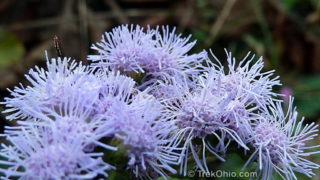 There's a crab spider lurking in the cluster of flowers pictured above. Crab spiders pretend to be part of a flower, and when an unsuspecting insect arrives to sample the flower's nectar, he'll pounce on it and have it for lunch. If you've spotted him (or given up trying), click the "Continue reading" link to see him plainly.
He's turned his body sideways so he can hold a couple of his legs straight up. He 's trying to pretend that his legs are stem-like structures. Now that I've
There's a crab spider lurking in the cluster of flowers pictured above. Crab spiders pretend to be part of a flower, and when an unsuspecting insect arrives to sample the flower's nectar, he'll pounce on it and have it for lunch. If you've spotted him (or given up trying), click the "Continue reading" link to see him plainly.
He's turned his body sideways so he can hold a couple of his legs straight up. He 's trying to pretend that his legs are stem-like structures. Now that I've 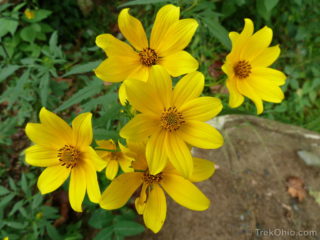 Below are a couple of dozen wildflowers that I photographed last month. I have numbered all the photos, so you can refer to the flower's number if you want to talk about a specific one. I haven't been able to identify all of them, so if you see one that you recognize please leave me a comment. Oh, and if you think I've misidentified any, I'd love to hear from you.
Below are a couple of dozen wildflowers that I photographed last month. I have numbered all the photos, so you can refer to the flower's number if you want to talk about a specific one. I haven't been able to identify all of them, so if you see one that you recognize please leave me a comment. Oh, and if you think I've misidentified any, I'd love to hear from you.
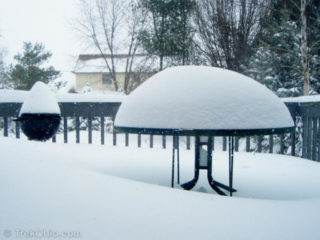 I decided to set up a bird feeder a few years back because there was just so much snow that year that I felt bad for the little creatures.
Although I originally thought I'd just feed the birds until the snow melted, I ended up feeding the birds all year. One of the rewards of feeding the birds in the summer is getting to watch the parent birds feed their young at the bird feeder. By the time that the young birds can fly around after their parents they are just about the same size as mom
I decided to set up a bird feeder a few years back because there was just so much snow that year that I felt bad for the little creatures.
Although I originally thought I'd just feed the birds until the snow melted, I ended up feeding the birds all year. One of the rewards of feeding the birds in the summer is getting to watch the parent birds feed their young at the bird feeder. By the time that the young birds can fly around after their parents they are just about the same size as mom 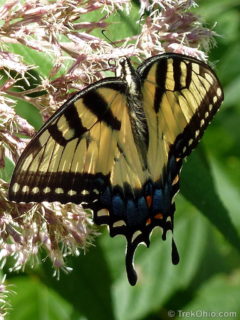 Butterflies with elegant projections extending from their hind wings are known as "swallowtails"; the swallowtails can be seen clearly below. However as a butterfly ages, the outer edges of its wings start to wear away. The thin, little swallowtails are usually the first to go. So you may find yourself looking at a swallowtail species without seeing any swallowtails at all. The "tiger" part of this butterfly's name comes from the four black stripes that start at the outer, front edge of its wings
It's
Butterflies with elegant projections extending from their hind wings are known as "swallowtails"; the swallowtails can be seen clearly below. However as a butterfly ages, the outer edges of its wings start to wear away. The thin, little swallowtails are usually the first to go. So you may find yourself looking at a swallowtail species without seeing any swallowtails at all. The "tiger" part of this butterfly's name comes from the four black stripes that start at the outer, front edge of its wings
It's 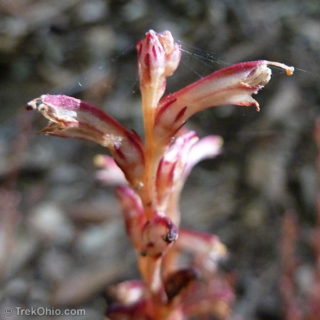 Most plants are green because of their chlorophyll which both tints their leaves and allows them to manufacture their own nutrition. However there are plants without chlorophyll; these plants aren't green, nor do they have leaves. So they turn to other living things to meet their nutritional needs. There are two categories of plants without chlorophyll depending on whether the plant directly gets its nutrition from another plant, or indirectly via a fungus which in turn gets its food from a plant.
Most plants are green because of their chlorophyll which both tints their leaves and allows them to manufacture their own nutrition. However there are plants without chlorophyll; these plants aren't green, nor do they have leaves. So they turn to other living things to meet their nutritional needs. There are two categories of plants without chlorophyll depending on whether the plant directly gets its nutrition from another plant, or indirectly via a fungus which in turn gets its food from a plant.